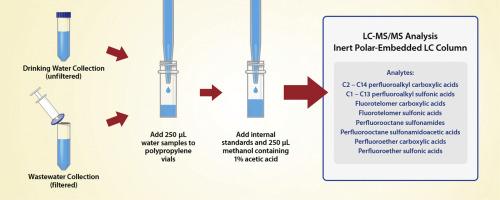利用 LC-MS/MS 将超短链化合物纳入饮用水和非饮用水中的全氟和多氟化物的综合分析中
IF 3.2
引用次数: 0
摘要
超短链(USC)全氟烷基和多氟烷基物质(PFAS)是碳链长度短于 C4 的小型极性化合物。它们在环境水生系统中无处不在且含量很高,正在成为一个令人担忧的重大问题,其严重程度可与长链全氟烷基磺酸污染相关的既定问题相媲美。因此,必须同时分析水样中的 USC 和长链 PFAS,以全面评估和解决全氟辛烷磺酸污染问题。USC PFAS 的极性很高,这对 PFAS 分析中的标准色谱操作提出了挑战,主要原因是色谱保留时间不足。本研究开发了一种简单可靠的工作流程,用于同时分析饮用水和非饮用水中的 C1 至 C14 全氟烷基羧酸和磺酸以及其他类别的 PFAS。色谱分离采用极性嵌入式反相液相色谱柱,硬件上有惰性涂层。选择了三种不同的水基质(自来水、瓶装水、污水处理废水)进行方法评估,以证明所开发的工作流程适用于测量不同水样中的 45 种 PFAS 化合物。在 2 至 250 纳克/升的五个强化水平下,通过准确度和精密度分析,对稀释-检测工作流程进行了评估。在 100 纳克/升的样品中加入 18 种同位素标记的 PFAS 作为提取内标,以验证整个工作流程的准确性。由于反渗透水对所有分析物都很洁净,因此校准标准用反渗透水制备。不同分析物的校准范围各不相同,从 1 毫微克/升到 1000 毫微克/升不等。所有分析物和提取的内标在所有强化水平下的回收率为标称浓度的 70% 至 130%。方法的精确度令人满意,%RSD 值低于 20%。为了进一步证明所建立的工作流程适用于对各种水基质中的目标 PFAS 进行准确定量,还对从各种源水中收集的其他饮用水和非饮用水进行了测试。本文章由计算机程序翻译,如有差异,请以英文原文为准。

Incorporating ultrashort-chain compounds into the comprehensive analysis of per- and polyfluorinated substances in potable and non-potable waters by LC-MS/MS
Ultrashort-chain (USC) per- and polyfluoroalkyl substances (PFAS) are small and very polar compounds with carbon chain lengths shorter than C4. Their ubiquitous and high levels of occurrence in environmental aquatic systems are emerging as a significant concern, rivaling the well-established issues associated with long-chain PFAS contamination. Therefore, it is important to analyze both USC and long-chain PFAS together in water samples to comprehensively assess and address the full spectrum of PFAS contamination. The high polarity of USC PFAS poses a challenge for standard chromatographic practices in PFAS analysis, primarily due to insufficient chromatographic retention. In this study, a simple and reliable workflow was developed for the simultaneous analysis of C1 to C14 perfluoroalkyl carboxylic and sulfonic acids, along with other groups of PFAS, in both potable and non-potable waters. The chromatographic separation was conducted using a polar-embedded reversed-phase LC column with an inert coating on the hardware. Three different water matrices (tap water, bottled water, sewage treatment wastewater) were chosen for method evaluation to demonstrate the applicability of the developed workflow for measuring 45 PFAS compounds in diverse water samples. A dilute-and-shoot workflow was evaluated by accuracy and precision analysis at five fortification levels, ranging from 2 to 250 ng/L. Eighteen isotopically labeled PFAS, serving as extracted internal standards, were added to the samples at 100 ng/L to validate the accuracy of the entire workflow. Calibration standards were prepared in reverse osmosis water due to its cleanliness for all analytes. The calibration ranges varied among different analytes, spanning from 1 – 1000 ng/L. All analytes and extracted internal standards exhibited recovery values ranging from 70% to 130% of the nominal concentration across all fortification levels. Satisfactory method precision was demonstrated with %RSD values below 20%. Additional potable and non-potable waters collected from various source waters were tested to further demonstrate that the established workflow is suitable for the accurate quantification of targeted PFAS in a wide range of water matrices.
求助全文
通过发布文献求助,成功后即可免费获取论文全文。
去求助
来源期刊

Journal of chromatography open
Analytical Chemistry
CiteScore
2.50
自引率
0.00%
发文量
0
审稿时长
50 days
 求助内容:
求助内容: 应助结果提醒方式:
应助结果提醒方式:


